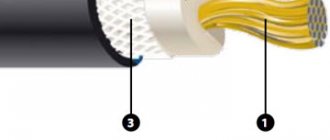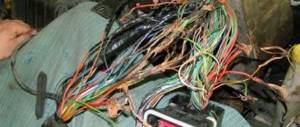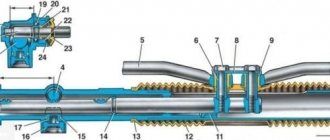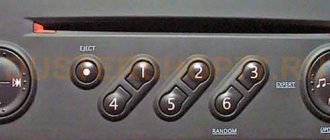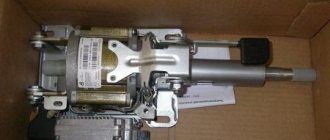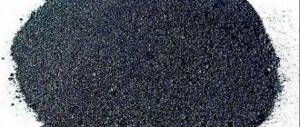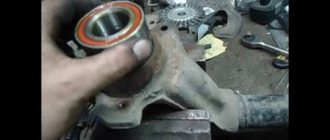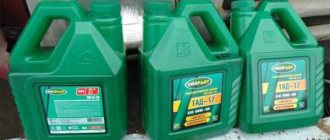A car, like any human technological invention, can be said to be crammed with electronics. In modern cars, by pressing one button you can simultaneously raise all the windows and lock the doors, all the headlights come into operation thanks to electronic impulses flowing through the wires, the wires come from the battery, and this list can be continued for a very long time. But due to various circumstances, wire connections may fail. In some it is corrosion, in others it is oxidation, in others it is short circuits due to moisture getting on the contact, etc.
However, there is an excellent way out of the situation - contact lubricant, which can prevent all destructive processes or stop them.
Lubricant for car contacts
Operating principle and beneficial effect
Despite the fact that lubricants for electrical contacts from different manufacturers have different chemical compositions, their principle of action is approximately the same. The following are the main functions of lubricants:
- displacement of moisture;
- isolation from water and oxygen, which significantly reduces oxidative processes;
- protection against such phenomena as current leakage;
- reduction of contact resistance in the contact area of the terminals;
- penetration into oxide and sulfide deposits, which stops corrosion processes and liquefies deposits on the contact surface.
That is, after treatment with such a lubricant, oxidative processes in contacts slow down greatly or stop altogether. This significantly increases the reliability of car wiring and extends the service life of terminals and contacts.
Universal electrical insulating grease
The optimal solution to the problem of maintaining the functionality of electrical contacts is EFELE Grease for electrical contacts.
It is intended for automobiles, industrial and household equipment. The material contains silicone liquid, an inorganic thickener and an additional additive package.
EFELE dielectric grease is a homogeneous, thick, white composition. It holds well at the joint, does not drain, does not dry out during operation, and retains its properties throughout the entire life of the equipment.
Main advantages of the material:
Has high dielectric properties.
It is heat and frost resistant. The composition is used in a wide range of operating temperatures: -40 °C…+160 °C
Prevents the formation of corrosion and oxidation
Not washed out by water and weak acidic and alkaline solutions
Protects contacts from short circuits
Prevents current leakage from the connection
Reliably seals and insulates
Compatible with most plastics and elastomers
Liqui Moly lubricant and its analogues
Let's look at several popular lubricants used for automotive wiring contacts, starting with the most famous and suitable for this purpose.
- Liqui Moly. The manufacturer produces electrically conductive lubricants in two forms: aerosol (Electronic Spray) and gel (Batterie-Pol-Fett). Grease is more effective in the long term, as it is resistant to water washout and begins to drain spontaneously only after heating to 145 °C. However, using grease for hard-to-reach places is inconvenient, since it must be applied by contact. Aerosols are well suited for quickly treating contact surfaces, including hard-to-reach ones. But the effect of aerosols is short-lived. For effective protection, contacts will need to be treated at least once every 3 months.
- Solid oil or lithol. These are traditional lubricants for battery terminals and other car contacts. They are not entirely suitable for such purposes, since they do not provide sufficiently reliable protection against oxidation and dry out quite quickly. Requires frequent updating. Used mainly by old school drivers.
- Graphite grease. The main disadvantage of this oxidation protection agent is partial electrical conductivity and low spontaneous drainage temperature. Suitable for processing single contacts (battery, starter, generator). If small, multi-pin chips are lubricated, it can cause current leakage with accompanying malfunction of the electronics.
Contact lubricants are a good solution for those motorists who do not want to deal with the problems of wiring oxidation.
One of the conditions for normal charging of a car battery is good contact between the terminal and the contact on the battery body. To avoid oxidation and deterioration of contact, it is necessary to lubricate the contacting surfaces with a special composition.
Methods of using silicone grease
Silicone lubricant, due to its consistency (plasticity), is able to penetrate into the most inaccessible places, therefore it is excellent for processing car door locks. Inject a small amount of lubricant into the lock, and the locks will always delight you with easy opening in any weather, both winter and summer.
Silicone is frost-resistant and does not absorb moisture. Everyone knows how difficult it can be to open car doors after washing in winter, even after blowing out the lock slots with compressed air. This can be easily avoided. After washing your car in winter, ask the wash workers to blow out the locks and hinges of your car, and then spray the locks and hinges with silicone yourself. After this, you will forget about the problem of locks until the next wash.
Silicone grease is ideal for treating seals on car windows and doors. After washing the car, wipe the seals with a dry cloth, and then treat them with silicone by spraying them from an aerosol can.
Try to spray without drips, you don’t need to pour a lot, and be sure to wipe off the excess with a sponge. The lubricant will restore the elasticity of the seals and cover them with a water-repellent layer. In winter, in cold weather, the seals will not freeze, they will be elastic all year round and look like new.
What problems can lubrication solve?
Using a special lubricant to avoid oxidation of the contacts on the battery terminals simultaneously solves several problems:
ATTENTION! A completely simple way to reduce fuel consumption has been found! Don't believe me? An auto mechanic with 15 years of experience also didn’t believe it until he tried it. And now he saves 35,000 rubles a year on gasoline! Read more"
- allows you to increase the contact area - which reduces electricity losses;
- protects the surface of lead and other metals involved in contacts from oxidation.
The last point is especially important. When a vehicle is used for a long time in a humid environment, the surface becomes coated with oxide. Which leads to worsening contact. Moreover, in some older vehicles, the crimp terminals are made of copper. Together with lead, it formed a galvanic couple.
TOP 5 lubricants for battery terminals
So, of all the lubricants under consideration, not all are very effective and truly worthy of praise, so with more than 10 compositions, only 5 of the best terminal care products can be identified. Their assessment is a subjective opinion, based on such criteria as: reliability of the layer - how much it protects the terminals from corrosion and oxides (direct purpose), retention time elimination of sliding discharges, simplicity of the application process, wide temperature range of operation.
| Lubrication | Base type | Viscosity | Operating temperature,℃ | Tightness | Acid resistance |
| Molykote HSC Plus | Oily | High | -30°C… +1100°C | High | High |
| Berner battery pole spray | Oily | average | -30°C… +130°C | High | High |
| Presto Batterie-Pol-Schutz | Wax | average | -30°C… +130°C | High | High |
| Vmpauto MC1710 | Oily | High | -10°С… +80°С | High | High |
| Liqui Moly Batterie-Pol-Fett | Oily | High | -40°C… +60°C | High | High |
A high-quality terminal lubricant should have a whole range of properties:
- Acid resistance
. The main task: to prevent the development of oxidative processes, to stop those that have already begun. - Tightness
. The product must simultaneously displace moisture, condensation, and protect against oxygen! - Dielectricity
. Eliminating the occurrence of stray currents allows you to use battery power economically and efficiently. - Viscosity
_ One of the important quality criteria. Excessive fluidity may not have the best effect on battery protection: under high temperature operating conditions, thermal decomposition of lubricant molecules occurs, and you will have to apply it to the terminals again. - Wide operating temperature range
. The car is operated in different temperature conditions, so the terminal care product must retain its properties at both low and high temperatures. And it is desirable that it retains its viscosity.
What are the dangers of the presence of oxides on the contact surface?
It is necessary to carefully monitor the condition of the contacts - in some cases, replacing them or cleaning them yourself may not even help. The danger of using a car battery with soured contacts is obvious. Consequences:
- conductivity decreases - the voltage at the battery terminals supplied from the generator decreases;
- the voltage at the starter contacts decreases - the battery, due to poor contact, supplies low voltage to them and the shaft simply does not turn.
Contacts with sulfuric acid are especially dangerous. In some cases this can lead to really serious problems. Including terminal breakdowns - in particularly difficult cases. The presence of even a small layer of oxides leads to unpleasant consequences - poor contact does not allow the engine to start.
When to lubricate battery terminals
It is necessary to smear the battery terminals not when a layer of white oxide has already appeared there, but preferably before installing the battery or at least at the very beginning of the oxidation process. On average, terminal maintenance measures are required every two years. On modern maintenance-free batteries that do not require so much attention, the need to lubricate the terminals may arise after 4 years of operation. Although, by and large, it all depends on environmental conditions, the condition of the electrical wiring and battery. Since damage to the terminals, poor contact, overcharging from the generator, violation of the seal of the housing and the ingress of technical fluids only contribute to the formation of plaque.
What to do if the contacts have already oxidized?
You need to remember: if the surface of the terminals and contacts has already oxidized, it is useless to lubricate them. First, before applying lubricant, you need to clean the metal to a shine using:
- sandpaper - and it is advisable to initially process it with coarse sandpaper, and then with fine sandpaper (“zero” sandpaper);
- using a grinder with a brush installed on it - the process is faster, but you should act as carefully as possible.
Restoring the surface after oxidation must be carried out with the engine turned off, and the battery itself must be disconnected.
Combating loss of contact in machine wiring
The design of the machine includes many electrical devices. Consequently, there are a large number of connectors for connecting them. It is the latter that are the main sources of loss of contact in car wiring. But this happens with other nodes too. The most common reasons are contamination with oil or dirt, as well as oxidation of contacts. The last factor is especially relevant in the presence of humidity, which provokes electrochemical corrosion. It can also damage contacts very quickly.
Which elements are most susceptible to the influence of the factors described above? Firstly, the battery suffers. To prevent loss of contact, you need to clean its terminals. In addition, the inside of the terminal can be cleaned. A regular knife will do for this. Although it is better to use small round and flat files. The inner surface is cleaned with a round file, and the battery terminals with a flat file. It is worth noting that some terminals are treated with a thin layer of tin. It is not recommended to remove it.
Next you need to move on to the starter. It is advisable to dismantle and disassemble the solenoid relay. True, for this you need to unsolder its conclusions. If the contact bolts are worn out, they can be turned half a turn. In this unit, the tips of high-voltage wires often corrode. It is better to carry out all operations for cleaning oxidized parts with a needle file. The tips of high-voltage wires and the sockets of the coil and distributor are also often subject to corrosion. They are cleaned with a round or flat file. But you can also use sandpaper. However, the coil socket is usually difficult to access. Therefore, to clean it, it is better to purchase a special product in an aerosol bottle. It needs to be inserted into the socket, wait a while, and then remove it with a cotton swab. To clean the contacts of the ignition distributor slider, use a file. The breaker contacts are silver plated, so a needle file is not applicable in this case. To clean them, you need to wet a piece of nylon cloth with solvent or gasoline and gently wipe the contacts with it.
When contact is lost in electrical connectors, there may be several reasons: a broken wire at the connector input, a weak spring, oxidation.
On older cars, it is quite possible to clean the connectors with a needle file. On newer cars, it is better to use the above-described products in cylinders. The simplest way is to repeatedly connect/disconnect the connector. But this measure helps for a while. If the wire breaks, it is better to replace the contact. You can also twist the wire around the connector. Repair cables are available for sale with lugs already mounted, ready to be inserted into the connector. Finally, the last element that is susceptible to loss of contact is the switches. Contacts of non-separable units are treated with a cleaning agent. Next, you need to press the switch button several times. You can also use multi-purpose lubricant. If this step does not help, then you need to replace the switch.
What products should you use?
There is a large selection of different lubricants on sale that make contact more dense and of higher quality. All of them can be divided into two categories according to consistency:
- in the form of a spray;
- thick lubricant - paste.
The spray is easier to apply and there is no need to come into contact with the lubricant itself. But you should remember: when sprayed, it can get on some other surfaces (battery case, body). Lubrication in the form of a paste is much more practical in this regard. Many types of lubricants come with a special plastic spatula. With its help, you can carefully smear all contacts.
